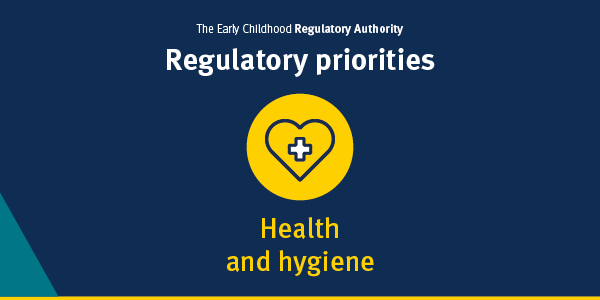Health and hygiene is a regulatory priority

Supporting and promoting the health, safety and wellbeing of children is one of the most important responsibilities of an early childhood education and care service. Approved providers, nominated supervisors and educators have a duty of care for all children in their service and must ensure they meet the individual health needs of each child.
See health and hygiene considerations below.
Did you know? National Regulation 77—Health, hygiene and safe food practices is one of the most commonly breached regulations.
The Early Childhood Regulatory Authority is seeing increasing non-compliance in health, hygiene and food practices, particularly as more early childhood services are providing food services.
Medical conditions
Supporting children's individual medical needs
Children's medical needs can be complex. Approved providers must ensure all staff are prepared to meet these complex needs. To prevent things from going wrong:
- understand requirements under
National Regulation 90
- be prepared for dealing with most common medical conditions in children, even if no children with those conditions are currently enrolled. Ensure
- staff and
educator qualifications, including first aid qualifications, are up to date and relevant for medical conditions that need to be managed at your service
-
policies and procedures are your key control—make sure they are based on the latest expert guidance, follow the
dealing with medical conditions in children—policy and procedure guidelines (PDF, 234KB) when developing and reviewing, and take all
reasonable steps (PDF, 606KB) to ensure staff follow them
- undertake adequate
risk assessment and implement mitigation strategies. Ensure each child with a medical condition has a
- medical management plan
- risk minimisation plan
- communication is essential—inform staff, educators and volunteers; work closely with the child's family and make sure you have their latest medical management plan. Ensure
- each child with a medical condition has a communications plan
- all staff members, educators and can locate the child's medication
- you give all parents or guardians of a child with a medical condition or allergy a copy of your medical conditions policy.
In an emergency situation, medication may be given to a child without a parent's authorisation—National Regulations 93(5)(b) and 94 set out these requirements, including notifying a parent as soon as practicable.
Did you know? Children over preschool age can self-administer medication if your service permits this. Such practices must be set out in your medical conditions policy, including how this is recorded in the child's medication record.
Managing children's medical needs videos
Whether it is knowing how to recognise an allergic reaction in babies, or being prepared if a child has a medical incident, these resources have tips to help services ensure they keep children safe.
Tips for managing children’s medical needs
From food allergies to medical conditions, find out how to manage and support children's sometimes complex medical needs to ensure every child goes home safely.